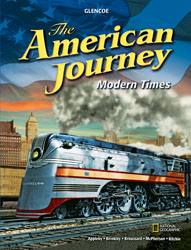
The American Journey Modern Times © 2009Chapter 13: The Cold War EraChapter OverviewsSection 1: Cold War Origins During World War II, the United States, the Soviet Union, and Great Britain worked out plans for the organization of the postwar world. In 1945, the United Nations was created to settle international disputes. The Soviets, however, set up Communist governments in Eastern Europe, increasing tensions with the United States. To contain communism, the United States sent aid to Western European countries, and successfully resisted a Soviet blockade of Berlin. The United States and the Soviet Union formed rival alliances. The Cold War competition for influence affected independence movements around the world. The Communist takeover of China’s government led to fears that all of Asia would fall to communism. In the United States, Senator Joseph McCarthy led a massive and damaging hunt to uncover Communist spies and supporters within the country. Section 2: Postwar Politics After World War II, the U.S. government lifted controls, and prices began to rise faster than wages. President Truman wanted to solve the nation’s economic problems and end labor strikes with a program of domestic reforms. The Republican-controlled Congress, however, wanted to limit government spending and reduce the power of labor unions. To make the federal government more efficient, Truman and Congress agreed to reorganize several departments and introduce new agencies. In 1948, Truman won a second term in a dramatic upset. Although Truman’s vision of Fair Deal reforms went unfulfilled, he was an important advocate for civil rights. Section 3: The Korean War At the end of World War II, Korea was split between a Communist-ruled North and an American-backed government in the South. When North Korean troops invaded South Korea in 1950, American troops fought North Korean forces under the United Nations’ flag. Despite early success under General Douglas MacArthur, the war became a stalemate. The General bitterly disagreed with Truman’s approach to fighting the war, which finally ended with a cease-fire agreement and no victory for either side. Section 4: America in the 1950s President Eisenhower promoted moderate policies during his two terms. Although he avoided ambitious new programs, he approved funding to build a network of highways across the nation. Meanwhile, the United States and the Soviet Union engaged in a dangerous nuclear arms race, which was eased somewhat by the Geneva Summit. A booming U.S. economy set off a baby boom and a surge of consumerism. Television changed American culture, as did the emergence of rock ‘n’ roll and a youth culture. Many farmers, Appalachians, and African Americans, however, did not share in the prosperity of the 1950s. Social critics blamed corporate and suburban life for America’s social problems. |  |















